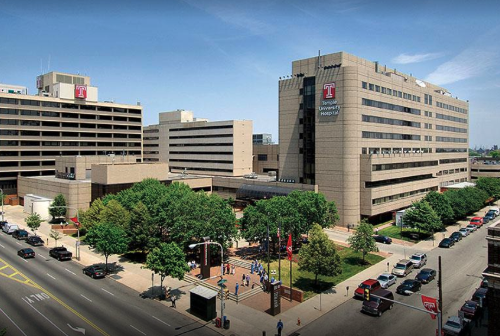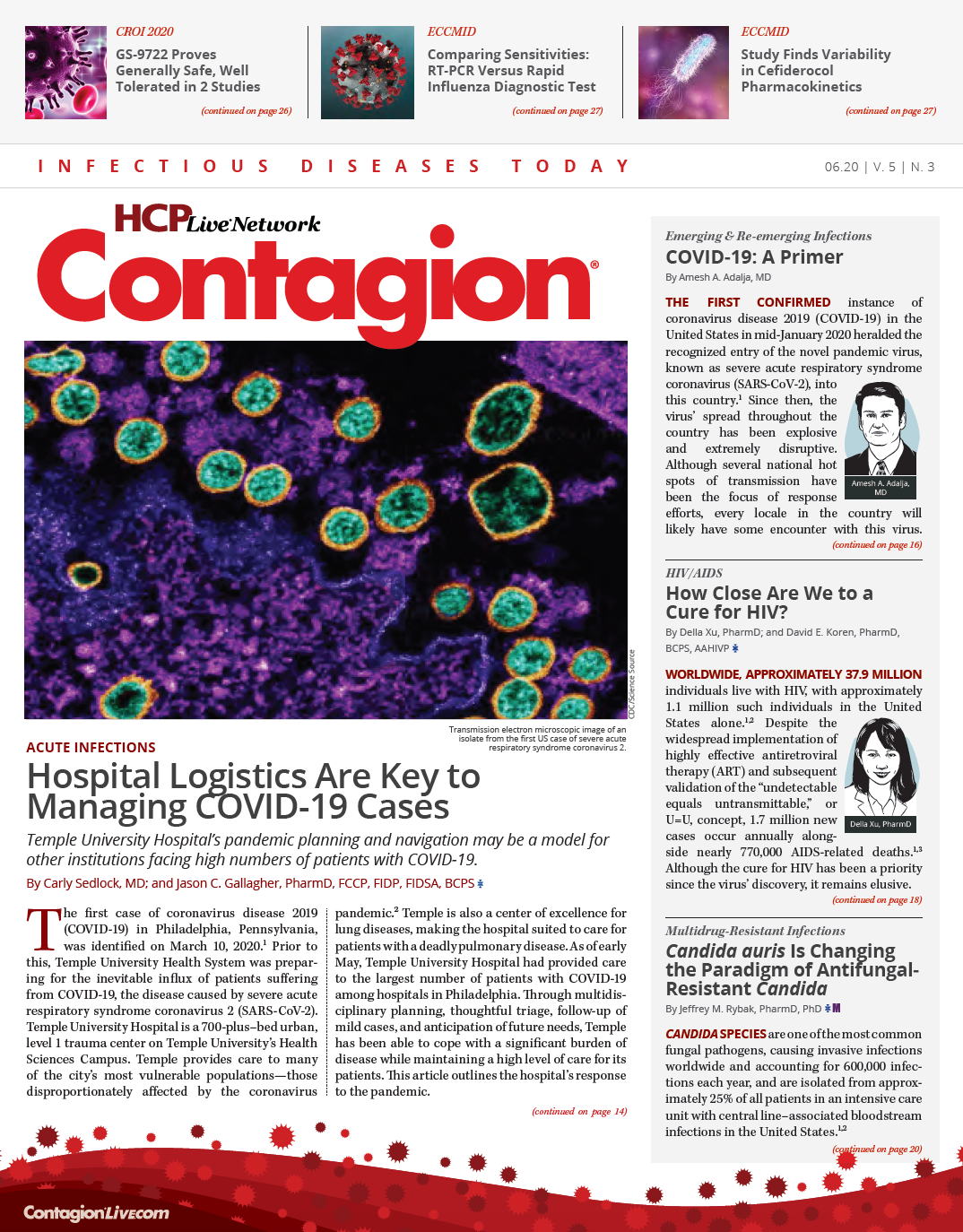COVID-19: How Temple University Hospital Is Addressing the Pandemic
The health system’s response could be used as a teaching model for addressing future infectious disease threats.

Temple University Hospital campus. Boyer Pavilion is on the left side, and Rock Pavilion is on the right.
The first case of coronavirus disease 2019 (COVID-19) in Philadelphia was identified on March 10. Prior to this, Temple University Health System was preparing for the inevitable influx of patients suffering from COVID-19, the disease caused by severe acute respiratory syndrome coronavirus 2 (SARS-CoV-2). Temple University Hospital is a 700-plus—bed urban, level 1 trauma center on the Health Sciences Campus of Temple University. Temple provides care to many of the city’s most vulnerable populations—those disproportionately affected by the coronavirus pandemic. Temple is also a center of excellence for lung diseases, making the hospital suited to care for patients with a deadly pulmonary disease. As of early May, Temple University Hospital has provided care to the largest number of patients with COVID-19 among hospitals in Philadelphia. Through multidisciplinary planning, thoughtful triage, follow-up of mild cases, and anticipation of future needs, Temple has been able to cope with a significant burden of disease while maintaining a high level of care for its patients. This article outlines the hospital’s response to the pandemic.
Leadership
The keys to an effective response to a crisis are leadership and organization. A multidisciplinary approach has been fundamental in the preparation for and navigation through this public health crisis. Voices from internal medicine, nursing, pulmonary/thoracic medicine, infectious diseases, emergency medicine, pharmacy, respiratory therapy, ventilator management, and those involved in infection control/procuring personal protective equipment (PPE) were all present in task forces and planning groups. The hospital administration let the voices of frontline clinicians guide policy decisions.
Clinical leadership for the COVID-19 response has come from Gerard J. Criner, MD, FACP, FACCP, director of the Temple Lung Center and chair of the Department of Thoracic Medicine and Surgery. His relationship with scientists in Wuhan, China, has helped inform Temple’s COVID-19 response by enabling frontline practitioners with experience to guide those who lacked it before our first patient was admitted. Dr. Criner has also been holding interdisciplinary systemwide daily video calls 6 days a week to allow clinicians, infection control, laboratory management, informatics personnel, and supply management to weigh in on evolving outcomes, policies, and treatment protocols. Each call begins with a COVID-19 update on the Philadelphia region, followed by expectations for the next week, specifics on Temple logistics, status, and anticipated needs.
Multiple groups have become leaders in the Temple COVID-19 response. The Section of Infectious Diseases has guided policy for infection control, PPE, and testing. An infectious disease attending is on call as the “COVID czar” 24 hours a day to answer clinical questions about testing and other policy questions. A designated hospitalist administrator handles questions about transfers, bed management, and patient disposition. Kathleen Reeves, MD, director of the Center for Urban Bioethics and senior associate dean of Health Equity, Diversity and Inclusion, has also been working to meet of the needs of Temple’s underserved patient population in the face of the pandemic. She has been leading efforts to deliver food to city residents, connect people to social services, and maintain utilities for the city’s residents.
Hospital Organization
To allow essential services to continue and to decrease the risk of nosocomial COVID-19 acquisition, hospital leadership took advantage of Temple University Hospital’s facility to create functional COVID-19 and non—COVID-19 hospitals. Temple University Hospital’s physical layout proved fortuitous for our response; Temple comprises 2 separate hospital buildings connected by a covered bridge. The main hospital building (the Rock Pavilion) has operated with normal services at reduced volumes. Meanwhile, Temple transformed the Boyer Pavilion, which usually houses several outpatient offices as well as a few inpatient floors and intensive care units (ICUs), into a separate 250-bed COVID-19 hospital. Physicians first admit patients with suspected COVID-19 to a service in Boyer as their status is determined. If they are polymerase chain reaction (PCR) negative and clinical suspicion subsides with an alternative diagnosis, for instance, staff transfer patients from Boyer to Rock (COVID-19 to non–COVID-19). If Rock patients are suspected of having COVID-19, as with an atypical or delayed presentation, staff transfer them to Boyer. With the canceling of elective procedures and decreased patient volumes in Rock, Temple has scaled up staffing in Boyer to accommodate patient volume. There is also a designated CT scanner in Boyer dedicated to patients with COVID-19, making diagnosis quicker and decreasing likelihood of nosocomial spread.
Triage
One of the keys to Temple’s approach has been triage, which starts with emergency department personnel. Clinical leadership created triage algorithms to facilitate consistency in patient care and bed management using clinical, radiological, and needs-based criteria (Figure 1). As the need for beds increased, administration quickly facilitated coversion of office spaces and lobbies in the building into patient wards and post anesthesia care units into ICUs. The capacity of the Boyer Pavilion has more than doubled.
Patients who present with mild disease and are treated with outpatient care are offered monitoring with the HGE COVID symptom tracking application, a website on which patients can log symptoms daily. This allows occupational health and primary care clinicians to assess outpatients based on patient-reported symptoms and act to redirect them to inpatient care if necessary.
Staffing Challenges
Shortly before patients with COVID-19 were admitted to Temple, hospital administration instructed nonessential and off-duty personnel to work from home, and experiential training for health sciences students ended. To maintain a viable, healthy workforce, medical residents had elective rotations canceled, and services included essential personnel only. Remote support using the electronic health record (EHR) has allowed clinical services to continue, even for essential services. Temple enacted a universal masking policy and temperature checks for anyone entering the hospital buildings.
As the crisis has progressed, Temple has had to adapt its staffing needs. An unanticipated increase in patients requiring renal replacement led to around-the-clock shifts for dialysis personnel. Laboratory leadership modified logistics in the microbiology lab to allow for increased frequencies of SARS-CoV-2 assays.
To allow our emergency department providers to effectively triage and manage cases of patients presenting with symptoms of COVID-19, the hospital has created various “pods” staffed by other specialties to triage and see patients with non—COVID-19 complaints. Triagers funnel patients presenting with chest pain and acute coronary syndrome to a “cardiology pod” staffed directly by cardiologists; a surgeon sees patients presenting with abdominal pain. This team approach extends to inpatient services as well. As inpatient volume has increased, Temple has created more COVID-19 care teams, and specialists have staffed these teams in several day blocks to relieve hospitalists. For example, a gastroenterologist or a nephrologist may oversee a COVID-19 floor team with the help of an internal medicine resident. Behind the scenes, outpatient providers embraced the use of telemedicine for the vast majority of patient needs.
Testing
Temple has been subject to the nationwide shortage of testing supplies for COVID-19. As in many institutions, Temple’s lab took advantage of Emergency Use Authorization to create and quickly validate in-house PCR-based testing. The lab also increased testing capacity through technician training and by running multiple testing shifts per day. Shortages of testing supplies have created challenges intermittently, and Temple has responded in several ways. When the ability to run assays became limited, send-out testing was used for situations in which turnaround time (TAT) was less urgent, as for confirming negative assays before removal from isolation. Temple has pursued alternative platforms as well. Laboratory leadership investigated Abbott’s ID Now platform for outpatient settings, but they were ultimately unable to procure the system. The recent addition of the Cepheid platform to the laboratory’s toolset has allowed for a rapid TAT of the SARS-CoV-2 assay when time was essential. Infectious Diseases is also using diagnostic stewardship by fielding clinical questions regarding testing and developing a retesting policy for the institution that conserves both testing resources and PPE.
Clinical Management and Treatment
Temple’s pulmonary and critical care physicians have been the frontline managers in the treatment of patients with COVID-19 infection. As mentioned, we created tiers for patient management and escalation of level of care to quickly identify the need for escalating care. Temple has employed early strategies for noninvasive ventilation, including use of high-flow oxygen and prone positioning to decrease rates of intubation.
Temple developed its treatment algorithm for COVID-19 with input from many disciplines, and it has evolved continuously. To preserve PPE, principles of the algorithm are to preferentially use less frequently dosed regimens (eg, enoxaparin over heparin) and those that do not require specific laboratory blood draws (eg, linezolid over vancomycin). Informatics created a panel in our EHR specifically for monitoring patients with COVID-19, including vitals, laboratory values, and pertinent biomarkers.
With a lack of established therapies for COVID-19, early enrollment in clinical trials has been a primary therapeutic modality for our patients. We facilitate this through several means, including placement of available clinical trials in treatment pathways, prioritization of COVID-19 protocols by the Temple institutional review board, and the use of multiple personnel for consent. Because overlap exists between some of the inclusion criteria for studies, clinicians need to make decisions on enrollment based on clinical indication, not just eligibility.
Given the cytokine storm often seen in patients with COVID-19, Temple has used immunomodulatory therapies inside and outside clinical trials, including those that inhibit IL-1, IL-6, and granulocyte-macrophage colony-stimulating factor. Because both therapies are associated with increased risk of infection and blunt diagnostic markers of infection, infectious diseases physicians follow all patients who are prescribed or enrolled to receive one.
Workforce Support
A healthy workforce is necessary to adequately care for the surge of patients with COVID-19, and Temple has created policies and procedures with employee health in mind. Physicians on the COVID-19 services work 8-hour shifts to decrease provider fatigue, which can compromise patient and provider safety. Temple created an in-hospital testing site, which now primarily provides testing for symptomatic employees. Occupational health has also increased their capacity based on workforce need and has been flexible with workforce guidelines as institutional needs and circumstances have changed. The aforementioned HGE COVID symptom tracker is available for employees so they can track symptoms daily. Temple has also provided several services focusing on wellness, including provision of dorms at the undergraduate campus for health care workers to stay, free shuttle service in the city, and free mental health resources.
Conclusions
Despite many challenges, Temple, the largest COVID-19 hospital in Philadelphia, has succeeded in providing high-quality care to those most in need. Although the differences between hospitals in the United States are considerable, we believe that aspects of Temple’s approach can offer our medical peers examples to follow and adapt for their own institutions.
We are proud of Temple.
Sedlock is a first-year fellow in infectious diseases at Temple University Hospital.
Gallagher, editor-in-chief of Contagion®, is a clinical professor at Temple University School of Pharmacy and clinical pharmacy specialist in infectious diseases at Temple University Hospital, both in Philadelphia, Pennsylvania. He is also the director of the PGY2 Residency in Infectious Diseases Pharmacy at Temple. *He is an active member of the Society of Infectious Diseases Pharmacists.

